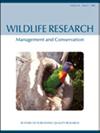Immobilisation efficacy of conducted electrical weapons on captive white-tailed deer
IF 1.6
3区 生物学
Q3 ECOLOGY
引用次数: 0
Abstract
Context Wildlife emergencies (e.g. injured animals) often require capture or humane dispatch of animals to resolve the situation. Conducted electrical weapons (CEWs) have the potential to immobilise white-tailed deer (Odocoileus virginianus) for a short duration to avoid potential risks of extended immobilisation (e.g. chemical immobilisation) and increase safety for managers and the public during humane killing by gunshot. Aims To test rapid immobilisation with minimal long-term physiological consequences of CEW immobilisation of white-tailed deer. Methods We arranged five treatment groups of captive deer, including (1) chemical immobilisation with 5-s CEW exposure (n = 5), (2) chemical immobilisation with 15-s CEW exposure (n = 5), (3) 5-s CEW exposure with no chemical immobilisation (n = 10), (4) 15-s CEW exposure with no chemical immobilisation (n = 10) and (5) a control group with no chemical immobilisation or CEW exposure (n = 10). We conducted treatments 1 and 2 to determine short-term physiological effects of CEWs on deer, related to overall welfare. In treatment groups 1 and 2, we sedated deer to collect blood immediately before CEW exposure, and 2 days and 5 days post-exposure for serum biochemical analysis (to measure physiological markers of organ and tissue damage). We observed deer before, during and after treatments to evaluate potential behavioural changes. Key results All deer showed signs of muscle paralysis immediately after exposure to CEW and regained muscle control immediately after the exposure ended. Serum biochemistry results for treatment group 1 and 2 revealed significant increases in creatine kinase (CK) and aspartate aminotransferase (AST) 2 days post-treatment, before returning to pre-exposure concentrations by day 5-post-exposure, suggesting temporary myopathy. By 15-days post-exposure, deer that were only exposed to the CEW had 27 of 39 (69%) remotely fired probes still attached. No long-term behavioural or physiological changes were observed post-treatment. Conclusions Our findings suggest that for immobilisation of white-tailed deer, short-term exposure to a CEW to is a potential alternative to typical capture techniques and can provide sufficient immobilisation to approach and humanely kill deer by gunshot if necessary in wildlife emergencies. Implications As with all capture techniques, trainings and protocols should be developed to ensure the safety of personnel and animals during CEW exposures.射电武器对圈养白尾鹿的固定效果
背景 野生动物紧急情况(如受伤动物)往往需要捕捉或人道驱赶动物来解决。电导武器(CEW)有可能在短时间内固定白尾鹿(Odocoileus virginianus),以避免长时间固定(如化学固定)的潜在风险,并在人道枪杀过程中提高管理人员和公众的安全。目的 测试对白尾鹿进行CEW固定的快速固定效果,并将其长期生理后果降至最低。方法 我们为圈养鹿安排了五个处理组,包括(1)化学固定与 5 秒 CEW 暴露(n = 5);(2)化学固定与 15 秒 CEW 暴露(n = 5);(3)5 秒 CEW 暴露与无化学固定(n = 10);(4)15 秒 CEW 暴露与无化学固定(n = 10);(5)无化学固定或 CEW 暴露的对照组(n = 10)。我们进行了处理 1 和处理 2,以确定 CEW 对鹿的短期生理影响(与整体福利有关)。在处理组1和处理组2中,我们对鹿进行镇静,以便在接触CEW前立即采集血液,并在接触后2天和5天采集血液,用于血清生化分析(测量器官和组织损伤的生理指标)。我们在处理前、处理中和处理后都对鹿进行了观察,以评估潜在的行为变化。主要结果 所有鹿在接触 CEW 后都立即出现肌肉麻痹症状,并在接触结束后立即恢复肌肉控制。处理组 1 和 2 的血清生化结果显示,肌酸激酶 (CK) 和天门冬氨酸氨基转移酶 (AST) 在处理后 2 天显著升高,在处理后第 5 天恢复到接触前的浓度,这表明存在暂时性肌病。暴露后15天,只暴露于CEW的鹿的39个遥控发射探针中有27个(69%)仍然连接在一起。治疗后没有观察到长期的行为或生理变化。结论 我们的研究结果表明,在固定白尾鹿方面,短期暴露于 CEW 是典型捕捉技术的一种潜在替代方法,可以在野生动物紧急情况下提供足够的固定,以便在必要时接近鹿并以人道方式开枪杀死鹿。影响 与所有捕捉技术一样,应制定培训和协议,以确保接触 CEW 期间人员和动物的安全。
本文章由计算机程序翻译,如有差异,请以英文原文为准。
求助全文
约1分钟内获得全文
求助全文
来源期刊

Wildlife Research
生物-动物学
CiteScore
4.30
自引率
15.80%
发文量
56
审稿时长
3 months
期刊介绍:
Wildlife Research represents an international forum for the publication of research and debate on the ecology, management and conservation of wild animals in natural and modified habitats. The journal combines basic research in wildlife ecology with advances in science-based management practice. Subject areas include: applied ecology; conservation biology; ecosystem management; management of over-abundant, pest and invasive species; global change and wildlife management; diseases and their impacts on wildlife populations; human dimensions of management and conservation; assessing management outcomes; and the implications of wildlife research for policy development. Readers can expect a range of papers covering well-structured field studies, manipulative experiments, and analytical and modelling studies. All articles aim to improve the practice of wildlife management and contribute conceptual advances to our knowledge and understanding of wildlife ecology.
Wildlife Research is a vital resource for wildlife scientists, students and managers, applied ecologists, conservation biologists, environmental consultants and NGOs and government policy advisors.
Wildlife Research is published with the endorsement of the Commonwealth Scientific and Industrial Research Organisation (CSIRO) and the Australian Academy of Science.
 求助内容:
求助内容: 应助结果提醒方式:
应助结果提醒方式:


